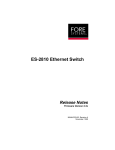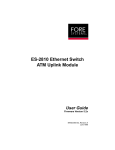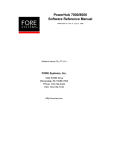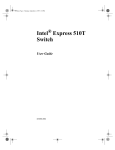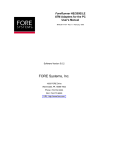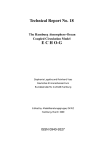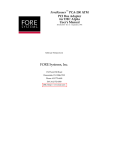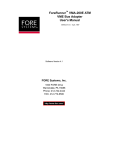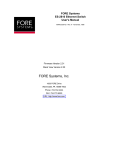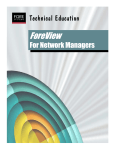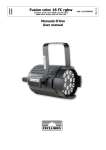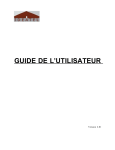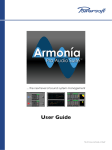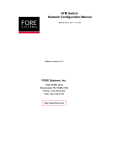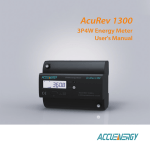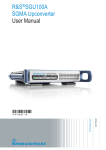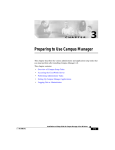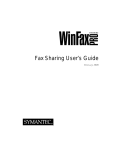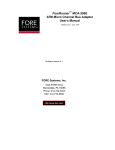Download ES-2810 Ethernet Switch Release Notes
Transcript
fs ES-2810 Ethernet Switch Release Notes Firmware Version 2.4x MANU0334-02, Revision A January, 1999 Legal Notices Copyright © 1999 by FORE Systems, Inc. FORE Systems, Inc. makes no representations or warranties with respect to the contents or use of this manual, and specifically disclaims any express or implied warranties of merchantability or fitness for any particular purpose. Further, FORE Systems, Inc. reserves the right to revise this publication and to make changes to its content, at any time, without obligation to notify any person or entity of such revisions or changes. All rights reserved. No part of this work covered by copyright may be reproduced in any form. Reproduction, adaptation, or translation without prior written permission is prohibited, except as allowed under the copyright laws. The information in this document is subject to change without notice. You must reproduce and maintain the copyright notice on any copy you make or use of the Programs. U.S. Government Restricted Rights. If you are licensing the Software on behalf of the U.S. Government (“Government”), the following provisions apply to you. If the Software is supplied to the Department of Defense (“DoD”), it is classified as “Commercial Computer Software” under paragraph 252.227-7014 of the DoD Supplement to the Federal Acquisition Regulations (“DFARS”) (or any successor regulations) and the Government is acquiring only the license rights granted herein (the license rights customarily provided to non-Government users). If the Software is supplied to any unit or agency of the Government other than DoD, it is classified as “Restricted Computer Software” and the Government’s rights in the Software are defined in paragraph 52.227-19 of the Federal Acquisition Regulations (“FAR”) (or any successor regulations) or, in the cases of NASA, in paragraph 18.52.227-86 of the NASA Supplement to the FAR (or any successor regulations). Trademark Notices FORE Systems, ForeRunner, ForeView, ForeThought, ForeRunnerLE, PowerHub and AVA are registered trademarks of FORE Systems, Inc. CellPath, EdgeRunner, Zero Hop Routing, MSC, TNX, Voice Plus, StreamRunner, Universal Port, ASN, CellStarter, Intelligent Infrastructure, I2, NetPro, FramePlus, ForeRunnerHE, ASX, Network Of Steel, and Networks Of Steel are trademarks of FORE Systems, Inc. All other brands or product names are trademarks of their respective holders. 1.0 General Description of Release ............................................... 5 For More Information ................................................................... 5 The README.TXT File ......................................................... 5 The On-Line Manual ............................................................. 5 The FORE Website ............................................................... 5 2.0 System Requirements............................................................... 6 Workstation Requirements for FORE’s Stack View..................... 6 3.0 Known Problems and Limitations............................................ 7 Installing Media Modules ............................................................. 7 Auto-negotiation Compatibility Issues ......................................... 7 Known Software Errors................................................................ 7 Connecting to a Matrix Module.................................................... 7 Before Using IGMP Pruning ........................................................ 8 ATM ELANs and Spanning Tree ................................................. 9 Example ................................................................................ 9 FORE Stack View Issues .......................................................... 10 “Monitoring --> STP statistics” Display................................ 10 FSV-to-switch Connectivity during VLAN Configuration ..... 10 VLAN / Filter Table Flush Feature Now Implemented......... 11 Assigning IP Addresses to a Switch After the Initial Install . 11 VLAN Status Information..................................................... 12 Miscellaneous User Interface Issues .................................. 12 Known Changes to the User’s Manual ...................................... 13 Version Number .................................................................. 13 Installing a Module (Section 1.6.4)...................................... 13 Switch Configuration (Section 7.2.7)................................... 13 Known Omissions in the User’s Manual .................................... 13 Warning When Using IGMP Pruning (Section 4.3.1) .......... 13 Approvals for Japan (Table 6.2).......................................... 13 Internet Explorer 4.0............................................................ 13 4.0 Link Aggregation ..................................................................... 14 5.0 Contacting Technical Support ............................................... 15 ES-2810 Ethernet Switch Release Notes iii iv ES-2810 Ethernet Switch Release Notes 1.0 General Description of Release The ES-2810 Switch has twenty-four 10/100Base-TX (RJ-45) ports and one Console port. You can install optional modules in the front slots. 1.1 For More Information The README.TXT File Refer to the README.TXT file on the FORE Stack View CD (supplied with the switch). The Quickstart Guides For information on the optional modules that can be installed in the ES-2810, such as the Matrix Module, refer to the quickstart guide included with the module. The On-Line Manual The on-line manual, contained on the FORE documentation CD included with the switch, contains in-depth information about the ES-2810. The file is in Adobe Acrobat format. If you already have the Acrobat Reader installed on your machine, you can simply run Acrobat and open the PDF file on the documentation CD. Or, you can install Acrobat using the files and directions on the FORE documentation CD. The FORE Website For the latest technical documentation and release notes for the ES-2810 and other FORE products, visit the FORE technical manual website at: http://www.fore.com/products/manuals.htm The website provides manuals in Portable Document Format (PDF). They can be viewed or printed using Adobe Acrobat Version 3.0 Readers. ES-2810 Ethernet Switch Release Notes Page 5 2.0 System Requirements If you are using FORE Stack View for Windows, you must use version FORE Stack View version 2.0 or later. 2.1 Workstation Requirements for FORE’s Stack View A PC with an Intel 486™ microprocessor or Pentium® D processor (recommended). Minimum 8 Mbytes RAM (16 Mb or more recommended). Hard disk with 5 Mbytes free disk space. SVGA color display, 800 x 600 resolution minimum, 16 colors (1024 x 768 in 256 colors recommended). One CD-ROM drive. Two or three button, Windows compatible mouse and driver. Page 6 ES-2810 Ethernet Switch Release Notes 3.0 Known Problems and Limitations 3.1 Installing Media Modules Media modules are not designed to be installed in, or removed from, the switch while it is in operation. You must power off the switch before attempting to install a media module. 3.2 Auto-negotiation Compatibility Issues Some devices do not support auto-negotiation fully. If you do not have a link after connecting the device to a switch, manually configure speed (10Mbps or 100Mbps) and duplex mode (Full or Half) on both the device and the switch to establish a link. 3.3 Known Software Errors A packet with CRC errors and a length of 64 bytes is counted as a runt. In the unlikely event of a large number of 100Mbps packets being received on a 10Mbps port using flow control, a small number of packets may be lost from traffic on other switch ports. Any port operating at 10Mbps that is receiving frames from a 1000Mbps port will drop all of the frames. 3.4 Connecting to a Matrix Module If you want to attach this switch to a Matrix Module which is attached to other switches with different firmware (for example, version 2.2x), you must upgrade the firmware of the other switches to version 2.3x or greater. To upgrade the other switches to the most recent firmware version: 1. Remember which switch is connected to your PC, and upgrade this switch last. 2. Install FORE Stack View 2.0 3. Open one of the other switches and manage it as a single device. (Select “Manage as a single device” in any of the dialog boxes.) 4. Download the new software from the CD or the FORE TACTics Web Page, as described in “Contacting Technical Support” on page 15. 5. Repeat steps 3 and 4 for the each of the other switches attached to the Matrix Module. 6. Connect this device to the Matrix Module. You can now manage all the devices attached to the Matrix Module as a stack. ES-2810 Ethernet Switch Release Notes Page 7 3.5 Before Using IGMP Pruning IGMP pruning should always be enabled on the ES-2810 when it is connected between the device receiving the multicast traffic and an IGMP enabled routing device. Keep the following in mind when the ES-2810 is located between the multicast transmitter and the IGMP routing device: • If the port on the routing device cannot explicitly join the IGMP multicast group, IGMP pruning should be disabled on the ES-2810 • IGMP pruning can be enabled on the ES-2810 if the router itself can be configured so that the router port connected to the ES-2810 explicitly becomes a member of the multicast group via IGMP “join” messages. Page 8 ES-2810 Ethernet Switch Release Notes 3.6 ATM ELANs and Spanning Tree The Spanning Tree Protocol will incorrectly block paths when you have multiple VLANs configured on ports connecting switches connected by Stack Interface Modules and you are using ATM ELANs. This occurs when both: • Both switches have a SIM installed (no matrix module is used), and are connected back-to-back • The ATM ELAN feature enabled. The traffic on the VLAN (very likely the system, or management VLAN) for which the SIM is a member will forwarded, but the traffic for the other VLANs will be blocked incorrectly. In the VLAN containing the SIM ports, if there are multiple paths between the two switches, Spanning Tree will correctly block the lower priority path. However, if there are additional VLANs configured on ports connecting the two switches, Spanning Tree will incorrectly block those paths. Example For example, on Switch A and Switch B, connected by a SIM (a half-stack), there are two VLANs configured, VLAN1 and VLAN2. • Two ports on Switch A are in VLAN1 and are attached to two ports on Switch B in VLAN1. • VLAN1 includes the SIM ports. • Two other ports on Switch A are in VLAN2 and attached to two ports on Switch B in VLAN2. • The ATM ELAN option is enabled in VLAN/Routing Setup. In this arrangement, two paths exist between Switch A and Switch B in VLAN1. The Spanning Tree Protocol forwards VLAN1's traffic on one path and blocks the other path. However, in VLAN2, Spanning Tree incorrectly blocks both paths. No traffic from VLAN2 flows between Switch A and Switch B, because the SIM can be a member of only one VLAN with ATMSTP enabled. NOTE that this is only true when both switches have SIM's installed. If one switch has a matrix module installed, everything works properly. ES-2810 Ethernet Switch Release Notes Page 9 3.7 FORE Stack View Issues “Monitoring --> STP statistics” Display 1. The STP topology age counters do not work properly in the new FSV / GSM-1000 release when the ATMSTP (STP per VLAN) feature is enabled. We have observed two problems: a. The aging time displayed in “Monitoring --> STP statistics” display is not always accurate. A Spanning Tree topology change may result in the Aging timer incrementing to a value greater than 42,000,000. This symptom is intermittent, but is more likely to occur when multiple STP monitoring windows are open. Multiple windows means more than one window for the same switch in the stack or different switches. b. The STP age timer may not be reset when a topology change occurs once the counter is corrupted by this large value (see above). You may see the change counter increment but not reset the age timer. 2. MAC address of root bridge is not always updated correctly after an STP topology change. This symptom occurs when all the following three conditions are present: • a topology change to the Spanning Tree occurs due to a new switch becoming the root bridge by virtue of its lower priority than that of the current root bridge. • A “Monitoring --> STP statistics” window is active at the time of the topology change • The “Monitoring --> STP statistics” window contains information for a switch in the stack that contained the root bridge PRIOR TO the topology change. Closing this window (or windows) and then re-launching them after the reconfiguration has taken place will display the correct information. FSV-to-switch Connectivity during VLAN Configuration The following error messages have occurred occasionally while attempting to create or modify VLANs. The likelihood of encountering one of these error conditions increases with a heavy load on the CPU of any switch, or during periods of heavy network traffic. NOTE Page 10 Modifying the VLAN Configuration (clicking OK to close the VLAN configuration menu and apply changes) when any of the switches in the FSV display appear blue may cause the following problems. It is at these times of temporary SNMP connectivity loss between the switches and the management application that the problems are most likely to occur. ES-2810 Ethernet Switch Release Notes VLAN / Filter Table Flush Feature Now Implemented It is now possible to flush the contents of the VLAN MAC table (and hence the bridge filter table). This preempts the normal (5 to 9 day) aging timer for learned addresses. This feature is available only via the RS-232 console port. It is located under “Administrator -> Monitoring -> VLAN -> MAC-VLAN -> Flush MAC’s. NOTE It is recommended that this command be used with discretion due to the slow learning rate of the ES-2810. Using the command under heavy traffic conditions, or with a large number of active MAC addresses may adversely affect network throughput. 1. The title of the message window is Add VLAN policy and the contents of the window is: !Failed to write VLAN data to the switch VLAN error[56] 2. An ATM ELAN message box appears that states: “Failed to write VLAN data to the switch -- General Error.” Now disable ATMSTP, click OK, and then click “OK” on the main VLAN configuration menu. A message box with the error “Failed to release rights to edit VLAN -- FSV does not possess editing rights” appears. 3. The “Config --> VLAN” window will display ports as <50>, <50>, <131>, <132> instead of giving the conventional port name and number. 4. Ports are displayed as members of the system VLAN when they should be members of another, user-defined VLAN. These conditions all appear to be temporary conditions within the stack. Repeat the operation again to verify correct operation. Assigning IP Addresses to a Switch After the Initial Install Attempting to assign an IP address while the MAC address for the newly installed device is present on the screen, causes the error “Failed to assign IP address” to occur. The solution is to assign the IP address via the local management interface (using telnet or the RS-232 console port). Use the “Administrative --> Quick Setup” menu. ES-2810 Ethernet Switch Release Notes Page 11 VLAN Status Information Incorrect VLAN status information is displayed on the GUI: a. Click on “Monitoring --> VLAN --> Status”. It shows a dialog box with the IP addresses of the switches in the stack. b. Select any of the switch and choose OK. It displays the VLAN status information (among which are the VLAN assignments for the ports on that switch). c. Keep this window open and repeat the process to obtain VLAN status information for one of the other switches. The information displayed in the windows for all other switches will actually be the VLAN information for the first switch selected. The work-around is to close the VLAN status window for any particular switch before opening a display for any of the other switches. Miscellaneous User Interface Issues • The traffic distribution numbers are wrong on the GE port traffic distribution display with the ATMSTP feature enabled. This display is brought up by right-clicking on the GSM-1000 port and selecting “Port Details --> Distribution”. This display does not distinguish between broadcast / multicast /unicast traffic. The correct traffic distribution numbers can be obtained through local management display (via RS-232 or telnet). Go to the “Monitoring --> Port Overview” display, then select the GE port. • RMON statistics window may take several minutes to come up and display data, and takes approximately 2-3 minutes to close. • Stack hardware information display: - The values displayed by the first field is inconsistent with help. It shows the device name while the help says it should display the IP address. - The number of ports displayed is always 24 even when the switch has 28 ports. This count does not include the gigabit port. • The synchronization manager does not always alert the user that there are different versions of firmware present on the switches within a stack. • The User Discovery option on the Device menu is not active in this release of FORE Stack View. Although a dialog box appears when the option is chosen, settings and values entered in the dialog box have no affect. Page 12 ES-2810 Ethernet Switch Release Notes 3.8 Known Changes to the User’s Manual Version Number The firmware version number on the cover page should read 2.3x. Installing a Module (Section 1.6.4) Replace the text in step 4 with: 4. Insert the Matrix Module, Stack Interface Module or 1000SX Module into Slot A (you can insert the 10/100TX and 100FX Modules in either slot). 5. Place your thumbs just beneath the screws on the front panel of the module and push it in until it clicks in to place. Secure the module using the retaining screws. If you push the module in incorrectly, you may find the module will not connect with the motherboard. Switch Configuration (Section 7.2.7) In section 7.2.7, “Switch Configuration,” the file names listed are incorrect and should read as follows: • inxxxxxx.p contains all the basic configuration parameters. The last six characters are the last six hex characters of the MAC address. • stdalone.nvp contains the VLAN policy database. This file name is derived from the domain name. If the domain name is different, the file name will match the name of the domain. In section 7.9.2, there is an error in the example. Under the row ixxxxxx.p the entry given is in9eb003.p. The “n” is an invalid hex character. 3.9 Known Omissions in the User’s Manual Warning When Using IGMP Pruning (Section 4.3.1) Add the following text to the ‘Warning’: “IGMP pruning only works in the management VLAN. This means that IGMP pruning has no effect on VLANs which have not been set up with IP routing.” Approvals for Japan (Table 6.2) Delete “VCCI Class 1 ITE” from the column labelled ‘Standard’ in the ‘Emission’ row. Internet Explorer 4.0 Microsoft Internet Explorer must be installed on the PC that is running FORE Stack View 2.0.3. Internet Explorer is included on the FORE Stack View CD. ES-2810 Ethernet Switch Release Notes Page 13 4.0 Link Aggregation The following notes apply to link aggregation: • Port trunking can only be used with ports that are members of the system VLAN. • The Spanning Tree Protocol will block a 2-port trunk group in favor of a four-port trunk group. • Failure of one link in a 4-port group will aggregate the remaining traffic over only 2 of the remaining ports. A 3-port trunk link is not supported. • Ports cannot be aggregated across switches. Consecutive ports from the same switch only may be combined in trunk groups. • The rule for assigning ports to trunk groups is: - A 4 port aggregation in ES-2810 must start on a 4 port boundary (i.e.: Port 1,5,9,13…, or 21.). - A 2 port aggregation can start on any odd port number (i.e.: 1,3,5,7,9,11…) • Path or Link determination is calculated in the following way: - 2Port = XOR of the SMAC and DMAC = (Look at one least significant bit) 0 = Port 1 of aggregation - 1 = Port 2 of aggregation 4Port = XOR of the SMAC and DMAC = (Look at least two significant bits) 00 = Port 1 of aggregation 01 = Port 2 " " 10 = Port 3 " " 11 = Port 4 " " Page 14 ES-2810 Ethernet Switch Release Notes 5.0 Contacting Technical Support In the U.S.A., customers can reach FORE Systems’ Technical Assistance Center (TAC) using any one of the following methods: 1. Select the support link from FORE’s World Wide Web page: http://www.fore.com/ 2. Send questions, via e-mail, to: [email protected] 3. Telephone questions to the TAC at: 800-671-FORE (3673) or 724-742-6999 4. FAX questions to the TAC at: 724-742-7900 Technical support for customers outside the United States should be handled through the local distributor or via telephone at the following number: +1 724-742-6999 No matter which method is used to reach the TAC, customers should be ready to provide the following: • A support contract ID number • The serial number of each product in question • All relevant information describing the problem or question ES-2810 Ethernet Switch Release Notes Page 15 Page 16 ES-2810 Ethernet Switch Release Notes
















